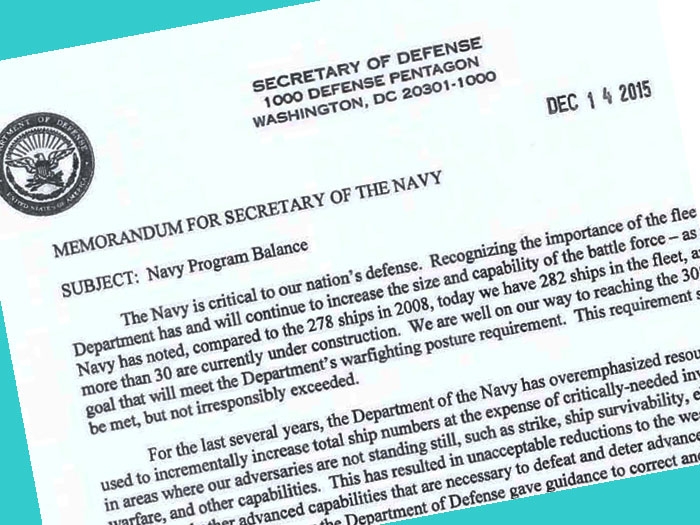
LCS downsize memo: Here’s what it says
Written by Nick Blenkey
DECEMBER 22, 2015 — As we reported last week, Washington defense industry commentators have been much engaged by a December 14 memo sent by Secretary of Defense Ash Carter to Secretary of the Navy Ray Mabus, essentially telling him to rethink the Navy’s budget priorities. Among other things, it directs him to reduce the Navy’s buy of littoral combat ships (including the upgunned versions that will be labeled as frigates) and two downsize to one of the two variants of the ship.
The memo has already prompted Congressional supporters of the LCS to promise to thwart any attempt to trim the shipbuilding program (see earlier story).
All this has left those of us outside the charmed circle of defense theologians, gurus and seers to wonder what the memo actually said. Wonder no more, the contents have now surfaced on the web and its text appears below. The only questions now are about who leaked it — and why.
SECRETARY OF DEFENSE
1000 DEFENSE PENTAGON WASHINGTON, DC 20301·1000
MEMORANDUM FOR SECRETARY OF THE NAVY
SUBJECT: Navy Program Balance
DEC 14 2015
The Navy is critical to our nation’s defense. Recognizing the importance of the fleet, the Department has and will continue to increase the size and capability of the battle force – as the Navy has noted, compared to the 278 ships in 2008, today we have 282 ships in the fleet, and more than 30 are currently under construction. We are well on our way to reaching the 308-ship goal that will meet the Department’s warfighting posture requirement. This requirement should be met, but not irresponsibly exceeded.
For the last several years, the Department of the Navy has overemphasized resources used to incrementally increase total ship numbers at the expense of critically-needed investments in areas where our adversaries are not standing still, such as strike, ship survivability. electronic warfare. and other capabilities. This has resulted in unacceptable reductions to the weapons, aircraft. and other advanced capabilities that are necessary to defeat and deter advanced adversaries. Earlier this year the Department of Defense gave guidance to correct and reverse this trend of prioritizing quantity over lethality; however, counter to that guidance, the Department of the Navy’s latest program submission fails to do so. It is accordingly unbalanced, creates too much warfighting and technical risk, and would exceed the numerical requirement of 308 ships.
I have made clear in our discussions, in my budgetary guidance, and in public remarks that our military is first and foremost a warfighting force, and while we seek to deter wars, we must also be prepared to fight and win them. This means that overall, the Navy’s strategic future requires focusing more on posture, not only on presence, and more on new capabilities, not only ship numbers.
The Department’s priorities are 1) to build advanced capabilities, 2) to close growing gaps in naval aviation, and 3) to ensure sufficient ship capacity. To meet these priorities, the Department will build to a total of 40 Littoral Combat Ships (LCS) and frigates (FF), the number that the Navy’s own warfighting analysis says is sufficient to need. This plan reduces, somewhat, the number of LCS available for presence operations, but that need will be met by higher-end ships, and it will ensure that the warfighting forces in our submarine, surface, and aviation fleets have the necessary capabilities and posture to defeat even our most advanced potential adversaries. Under this rebalanced plan, we will still achieve the Navy’s 308-ship goal, we will still. exceed 300 ships in each year from FYI9 to FY30, and we will be better positioned as a force to be overwhelming in posture rather than overextended in presence.
Specifically, the Department of the Navy will:
-
- Reduce the planned LCS/FF procurement from 52 ships to 40 ships (creating a 1/1/1/1/2 profile for eight fewer ships within the FYDP) by down-selecting LCS/FF production to one variant in FY2019. Forty LCS/FF will exceed recent historical presence levels and will provide a far more modern and capable ship than the patrol coastals, minesweepers, and frigates that they will replace. CAPE will provide specific implementation direction and the decision will be documented in the Resource Management Decision (RMD).
- Procure 10 Flight III destroyers (DDGs) within the FYDP. Recognizing the significant capabilities that Flight III destroyers provide, the Department will continue to procure 10 DDGs across the FYDP. In addition, we will upgrade additional Flight IIA DOGs, procure additional advanced electronic warfare capabilities, and invest in munitions that will enable the fleet to hold adversary surface ships at risk. The rebalance will allow us to upgrade a large portion of the current DDG fleet, while still protecting procurement of new DDGs.
- Maintain or increase production of key munitions. The Department must maintain an aggressive munitions procurement program to ensure that our surface, submarine, and aviation platfonns can engage our adversaries effectively. Contrary to the Navy’s amended submission, which reduced procurement to minimum sustaining rate across the board, the Department will maximize production of SM-6 missiles and maintain procurement of other advanced munitions. In addition, we will begin development of follow-on torpedoes so that the fleet can prosecute current and future advanced submarines and other targets.
- Maximize our undersea advantage. The Navy’s amended budget cuts two submarine combat system upgrades, reduces towed array procurement, and misses a key opportunity to add Virginia Payload Modules (VPM) to our fast attack submarines. VPM is the most cost-effective way to increase the capability and capacity of our submarines; therefore the Navy will invest in an additional Virginia Payload Module in FY20. Waiting until FY20 to procure an additional VPM will provide substantial time to allow the Navy to plan for and execute this increased workload even as production of the Ohio Replacement Program begins. The Department will also restore the two combat system upgrades cut in the Navy’s submission and procure an additional 10 SSN upgrades. These upgrades will ensure we continue to have the most lethal submarine force in the world.
- Procure 31 additional F-35C, additional F/A-18EIF, and continue upgrades to 4th generation fighters. To meet the expanding adversary fighter threat, we will procure 31 additional F-35C relative to the Navy POM submission (and 10 more than the PB-16 plan) to provide a substantial increase in 5th generation capacity. Procuring additional F/A-18E/F in 2018 will provide an early boost to naval aviation capacity, a particularly important investment given recent demands on aircraft for Operation Inherent Resolve. In contrast to the Navy’s most recent submission, the Department will also continue investments in 4th generation upgrades to ensure that these aircraft remain relevant in the high-end fight.
These decisions will modernize surface, subsurface, and aviation platforms and address many of the capability shortfalls that the Navy identified at the beginning of the budget process, even after accounting for the budget reductions in FY 17. These decisions will also ensure that the Navy does not need to execute many of the reductions to advanced capabilities that were proposed in the Navy’s amended submission, but which created unreasonable technical and warfighting risk. Specifically, the decisions outlined above will avoid:
-
- Cutting VPM and F/A·18E/F aircraft, two key additions that the Navy was previously directed to procure.
- The dramatic cuts proposed to procurement of our most modern munitions, including 420 AIM-120D missiles and 60 SM-6 missiles.
- The proposed reductions to surface ship electronic warfare capabilities and submarine combat systems, key upgrades that ensure our fleet remains relevant as threats advance.
- Disrupting our efforts to field infrared search and track capability, counter electronic attack radar upgrades, and Next Generation Jammer on Navy fighters, improving their lethality and survivability.
- Further cuts to aviation, such as the three E-2Ds and one MQ-4C Triton reductions that the Navy proposed.
- The 8 percent tax that was applied to a broad swath of programs in FYI 7, whose negative impacts may not be fully appreciated until the year of execution.
In order to further increase the capabilities of the fleet, in the upcoming RMD the Department will increase Navy resources by $1.7B over the FYDP to provide for many of the investments described above, including:
-
- 10 additional Submarine Combat Systems upgrades (SWFTS)
- Development of a new or upgraded lightweight torpedo
- Modernization of two additional Flight IIA DDGs
- 23 additional electronic warfare upgrades for the surface fleet
- Acceleration of the next generation torpedo countermeasureEnhanced modernization of TACTOM cruise missiles
- Additional upgrades to F8A aircraft
These choices will create a Navy that is far better postured to deter and defeat advanced adversaries, while still continuing to grow the size of the fleet. As both you and I have noted, ship count alone is a poor measure of the effectiveness of the force. With the rebalance laid out this memo, our fleet will not only be larger and more effective than it is today; it will also be equipped with the weapons and capabilities it needs to win any potential war.
The Department of Defense is relying on the Department of the Navy to support and carry out these critical strategic decisions.





Leave a Reply
You must be logged in to post a comment.